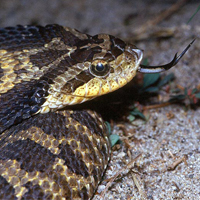Eastern Hog-nosed Snake
Scientific name: Heterodon platirhinos

Photo credit: Allen Woodliffe
Status
Threatened
“Threatened” means the species lives in the wild in Ontario, is not endangered, but is likely to become endangered if steps are not taken to address factors threatening it.
Date added to the Species at Risk in Ontario List
The Eastern Hog-nosed Snake was already listed as at-risk when the Endangered Species Act, 2007 took effect in 2008.
Read the most recent assessment report (PDF).
What it looks like
The Eastern Hog-nosed Snake is a non-venomous, thick-bodied snake that can grow up to one metre long. Some individuals are colourful and have distinct black-brown blotches while others are drab in their appearance. The easiest way to identify this snake is by its distinctive upturned nose and behavioural displays. When this harmless snake feels threatened by predators or humans, it coils up, flattens its head and neck to form a cobra-like hood, inflates its body, hisses loudly and strikes with a closed mouth. If this frightening display doesn’t scare the predator or person away, the snake rolls over and plays dead.
Where it lives
The Eastern Hog-nosed Snake specializes in hunting and eating toads, and usually only occurs where toads can be found. Eastern Hog-nosed Snakes prefer sandy, well-drained habitats such as beaches and dry forests where they can lay their eggs and hibernate. They use their up-turned snout to dig burrows below the frost line in the sand where eggs are deposited.
The Eastern Hog-nosed Snake is only found in eastern North America, with less than 10% of its range occurring in Canada. It is found in 34 states in the United States and in Ontario, Canada.
Where it’s been found in Ontario
The Canadian population is limited to Ontario where it can be found in two areas: the Carolinian Region and Great Lakes-St. Lawrence Region.
What threatens it
The most significant threats to the Eastern Hog-nosed Snake are:
- habitat loss from intensive agriculture and residential development
- increase in road networks and associated road mortality
- habitat fragmentation
- harming or killing by people
- nest predation by subsidized predators, meaning predator species whose densities have increased due to direct or indirect human actions affecting resource availability, such as the racoon
Action we are taking
This species and its habitat are protected under Ontario’s Endangered Species Act, 2007 (ESA).
The ESA also requires us to prepare recovery guidance for threatened species such as Eastern Hog-nosed Snake to guide recovery efforts for the species in Ontario.
All species listed on the Species at Risk in Ontario List may be eligible for consideration for government funding through the Species at Risk Stewardship Program.
Recovery strategy
A recovery strategy advises the ministry on ways to ensure healthy numbers of the species return to Ontario.
Read the executive summary and full document (December 7, 2011).
Government response statement
A government response statement outlines the actions the government intends to take or support to help recover the species.
Read the government response statement (July 9, 2012).
Five-year review of progress
A five-year review of progress made toward protecting and recovering a species is required no later than five years after the government response statement for that species is published.
Read the report on progress towards the protection and recovery of six species at risk, including Eastern Hog-nosed Snake (2017).
Habitat protection
General habitat protection - June 30, 2013
What you can do
Report a sighting
Submit your observations of species at risk to the Natural Heritage Information Centre (NHIC), which is Ontario’s conservation data centre. Join the centre’s Rare Species of Ontario project in iNaturalist, an online plant and animal identification app, to quickly and easily submit your observations.
Volunteer
Volunteer with your local nature club or provincial park to participate in surveys or stewardship work focused on species at risk.
Be a good steward
- Private landowners have a very important role to play in species recovery. If you find species at risk on your land, you may be eligible for stewardship programs that support the protection and recovery of species at risk and their habitats, such as the Species at Risk Stewardship Program.
- Every year, snakes all over the province must cross busy roads. Watch for snakes on the road, especially between May and October, when they are most active.
- Appreciate snakes and don’t harm them. Sadly, people continue to deliberately kill snakes. Keep the danger of snakes in perspective: all of Ontario’s snakes are non-venomous, except for the very rare Massasauga Rattlesnake.
- Visit the Herpetofaunal Atlas website to learn more about Ontario’s reptiles and amphibians and the data collected on them.
Report illegal activity
- Report any illegal activity related to plants and wildlife to
1-866-MOE-TIPS (663-8477) . - Never buy snakes that have been caught in the wild and never buy a native species of any kind that’s being sold as a pet.
Quick facts
- Snakes “smell” using their tongue instead of their nostrils. When they flick out their tongue they capture scent molecules, which are then pressed against a special organ inside the mouth called a vomeronasal organ.
- Unlike other snakes that tend to hibernate in groups, the Eastern Hog-nosed Snake usually spends the winter months alone. It may hibernate in a pre-existing burrow or dig a burrow in the ground with its snout.
- Most Eastern Hog-nosed Snakes reach maturity after two to three years. At the northern edge of its range, it takes Ontario individuals four to five years to become mature.